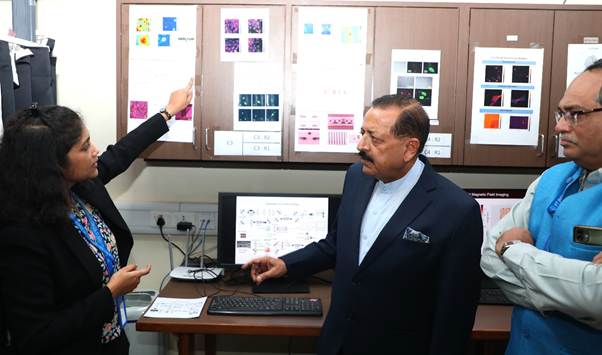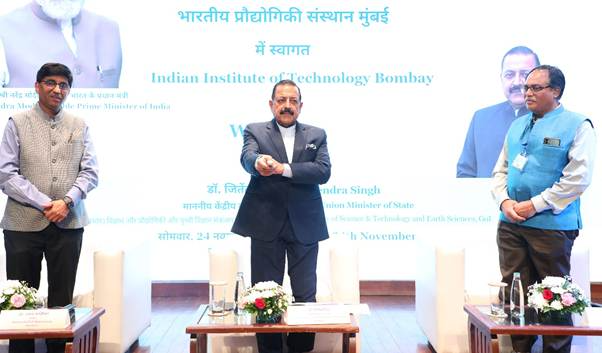Rs720 Cr Quantum Fabrication & Central Facilities Launched by Dr. Jitendra Singh; Quantum Diagnostics, Advanced Imaging, AI-Integrated Sensors Mark India’s Rising Deep-Tech Strength

FinTech BizNews Service
Mumbai, November 24, 2025: Union Minister of State (Independent Charge) for Science & Technology, Dr. Jitendra Singh, today announced the establishment of four state-of-the-art Quantum Fabrication and Central Facilities worth Rs720 crore across IIT Bombay, IISc Bengaluru, IIT Kanpur and IIT Delhi under the National Quantum Mission (NQM). Making the announcement during his visit to IIT Bombay, the Minister said that these cutting-edge facilities mark a decisive leap in India’s journey toward technological sovereignty, positioning the nation among the select global leaders advancing next-generation quantum technologies.

Dr. Jitendra Singh announced the establishment of four state-of-the-art Quantum Fabrication and Central Facilities worth Rs720 crore
The event was attended by senior leadership from the country’s premier scientific institutions, including Dr. Sireesh, Director of IIT Bombay; Dr. Abhay Karandikar, Secretary, Department of Science & Technology; Dr. N. Kalaiselvi, Director General, CSIR; Dr. Rajesh Gokhale, Secretary, Department of Biotechnology; senior faculty members of IIT Bombay; researchers; innovators; and representatives from the Technology Innovation Hubs and start-up ecosystem.
Dr. Jitendra Singh today reaffirmed the Government of India’s commitment to advancing frontier technologies by visiting the Quantum Research Laboratories at IIT Bombay and inaugurating the Institute’s new Liquid Helium Facility, an important milestone in India’s growing ecosystem of quantum science, cryogenics, advanced materials, and next-generation computing.
Dr. Singh said that under the visionary leadership of the Hon’ble Prime Minister, India has emerged as one of the earliest nations to launch a National Quantum Mission, reflecting the government’s willingness to embrace disruptive ideas and rapidly translate them into national initiatives. He added that the new fabrication and characterization capabilities, spanning quantum sensing, quantum computing, and quantum materials, will serve as the foundational hardware ecosystem needed to build sovereign, secure, scalable quantum devices and systems within the country. These facilities, he said, will be open not only to NQM investigators but also to academia, industry, start-ups, and strategic sectors across India.
Referring to IIT Bombay as one of India’s oldest and most respected science and technology institutions, the Minister noted that the institute has consistently partnered with the Department of Science & Technology (DST) since its inception, and continues to be a national leader in deep-tech domains. He highlighted that IIT Bombay and IIT Kanpur will anchor the nation’s quantum sensing and metrology infrastructure; IISc Bengaluru and IIT Bombay will advance quantum computing fabrication using superconducting, photonic and spin qubits; and IIT Delhi will host India’s quantum materials and device development ecosystem. These capabilities, he noted, will create a controlled environment for prototyping indigenous quantum devices, supporting translational research, and training the next generation of quantum hardware experts.
Dr. Singh recalled the remarkable evolution of science and medical technology over the years, from invasive diagnostic methods of the past to the emerging non-invasive, physics-driven therapeutics of today, and emphasized that quantum technologies will accelerate this transition further, enabling breakthroughs in healthcare, diagnostics, imaging, materials science, and advanced computing. He observed that India’s deep-tech innovations increasingly demand interdisciplinary training, adding that future medical education may very soon require physics as a core component. He praised institutions like IIT Bombay, IIT Kanpur and IISc for already moving toward integrated medical-tech research ecosystems.
The Minister stressed the importance of breaking silos and fostering multilateral collaboration among major institutes to translate academic R&D into real-world impact. He cited his own efforts in facilitating multi-institutional MoUs among IITs, AIIMS, IIMs, CSIR labs and communication institutes to ensure stronger market linkages, wider public dissemination of scientific breakthroughs, and more effective outreach to stakeholders such as students, farmers, and start-ups.
Speaking about IIT Bombay’s Technology Innovation Hub (TIH) under the National Mission on Interdisciplinary Cyber-Physical Systems (NM-ICPS), Dr. Singh noted that the hub has become a national model for translational research, supporting 96 technology development projects and more than 50 deep-tech start-ups. Among its 23 portfolio companies, several are already revenue-generating, with a combined valuation of ₹466 crore. He also emphasized the national importance of BharatGen, India’s first sovereign multilingual and multimodal AI initiative aimed at building large language models across 22+ Indian languages. He said that BharatGen’s text, speech, and vision models, and applications such as Krishi Sathi, e-VikrAI and Docbodh, represent India’s growing leadership in AI, data sovereignty and inclusive digital innovation.
Dr. Singh highlighted that many farmers and citizens remain unaware of scientific breakthroughs meant for their benefit, urging institutions to actively demonstrate technologies on the ground. Referring to examples from IMD, CSIR and agricultural missions, he said that the true test of innovation lies in its reach and acceptance by those who need it most. He urged IIT Bombay and all NQM institutions to ensure wider awareness, including demonstrations for farmers, students, and early-stage learners, so that India’s next generation can discover its scientific aptitude early.
The Minister added that the new quantum fabrication and centralized facilities will become a national pride asset, just as India’s space achievements such as Chandrayaan have elevated the global esteem of Indian youth and scientists. He said that India is witnessing a democratization of science, where even non-degree holders and rural innovators are building successful technology enterprises such as lavender-based biotech start-ups, proving that innovation is no longer confined to elite institutions.
Dr. Singh concluded by saying that the National Quantum Mission, NM-ICPS and BharatGen collectively represent India’s bold strides toward a future defined by deep-tech leadership, knowledge sovereignty, and Atmanirbhar Bharat. He said that the ₹720-crore quantum facilities will act as a springboard for India to build globally competitive quantum hardware and will accelerate the nation’s rise toward Prime Minister Modi’s vision of a Viksit Bharat by 2047. “These facilities,” he said, “will empower India to design, fabricate and scale its own quantum technologies, ushering in an era of sovereign, secure and world-class scientific innovation.”
During his visit to the Quantum Lab, the Minister reviewed India’s first series of indigenous quantum sensing and imaging platforms that signal a major leap in the nation’s R&D capabilities. He was briefed on QMagPI, the country’s first portable magnetometer capable of detecting ultra-low magnetic fields at the nanotesla (nT) scale. Developed using nitrogen vacancy (NV) centers-atomic-scale defects in diamond, the device enables high-precision magnetic sensing for strategic sectors, defense applications, mineral exploration, and scientific instrumentation. The Minister appreciated the team’s achievement in creating a compact, scalable system that places India among a select group of nations with such capabilities. He noted that the Department of Science & Technology (DST) has supported this advancement, enabling translation of deep science into real-world applications.
The Minister also witnessed India’s first indigenous Quantum Diamond Microscope (QDM), built by IIT Bombay’s PQuest Group. Powered by NV centers in diamond, the QDM allows nanoscale, three-dimensional magnetic field imaging and is poised to revolutionize widefield mapping in neuroscience, materials research, and semiconductor diagnostics. Integrated with AI/ML systems, the technology promises new breakthroughs in electronics, biology, geology, and next-generation chip testing, key pillars for India’s future technological leadership.
Highlighting the growing role of quantum technologies in healthcare, the Minister examined the Q-Confocal system, a homegrown confocal microscope engineered to exploit quantum properties of NV centers in nanodiamonds. Using T₁ relaxometry, this system enables sensitive detection of intracellular changes, particularly Reactive Oxygen Species (ROS) levels, which are critical for early-stage cancer diagnostics. Successful experiments on U87-MG glioblastoma and keratinocyte cells demonstrate the ability of the platform to measure disease-related changes at the nanoscale. Dr. Singh commended the innovation team and underlined that such quantum-enabled biomedical tools represent India’s increasing convergence of health sciences and high technology.
Following the lab visit, Dr. Jitendra Singh inaugurated the Liquid Helium Facility, describing it as a foundational national research asset that will significantly boost India’s capabilities in cryogenic engineering, superconductivity, quantum computing, quantum sensing, photonics, healthcare technologies, and green energy devices. Highlighting that liquid helium is indispensable for MRI systems, advanced materials characterization, and cryogenic electron microscopy (cryo-EM), he noted that the new facility, now dedicated to the nation and open for use by industries, universities, and research institutes- is equipped with an efficient helium recovery system that is expected to reduce the cost of cryogenic experiments to nearly one-tenth of current expenses while conserving one of the world’s rarest resources.
The Minister said that as global demand for quantum computers rises, India must simultaneously strengthen its cryogenics infrastructure. He noted that quantum computing depends critically on dilution refrigerators, which operate at ultra-low temperatures of around 10 millikelvin (below –272°C). Since these systems rely on advanced cryogenic support, the inauguration of the Liquid Helium Facility lays the foundation for future indigenous development of dilution refrigeration units, a strategic requirement for India’s long-term technological self-reliance. He acknowledged that unlike the quantum technologies reviewed earlier, the Liquid Helium Facility has not yet received DST support, pointing to the need for greater national collaboration to scale indigenous cryogenic capabilities.
Dr. Singh stated that both the Quantum Lab advancements and the new cryogenics facility reflect India’s fast-expanding leadership in next-generation science and technology. He said these achievements align with Prime Minister Narendra Modi’s vision of a Viksit Bharat, where deep-tech research, strategic innovation, and indigenous development drive India’s global competitiveness. He added that IIT Bombay’s work demonstrates how academia, government, and industry can jointly build a world-class scientific ecosystem capable of shaping the technologies of the future.
The Minister congratulated the researchers, faculty, and students of IIT Bombay for their pioneering contributions and assured continued government encouragement for breakthroughs in quantum science, cryogenics, healthcare innovation, and national technology missions.